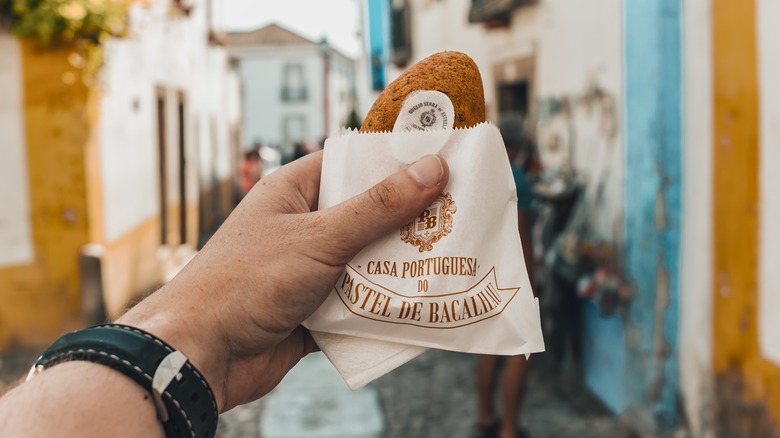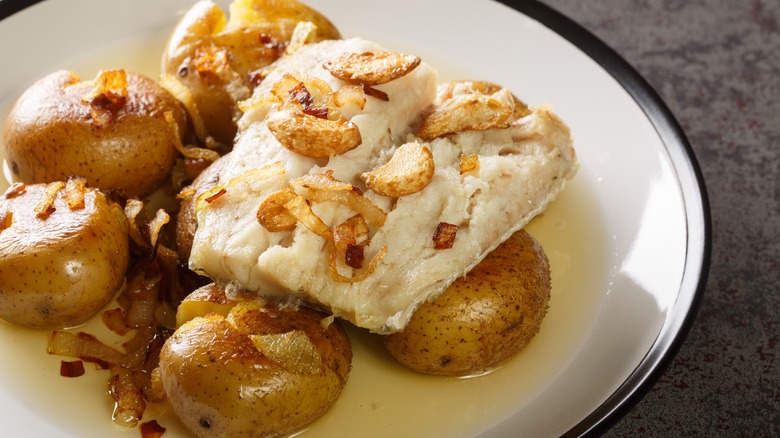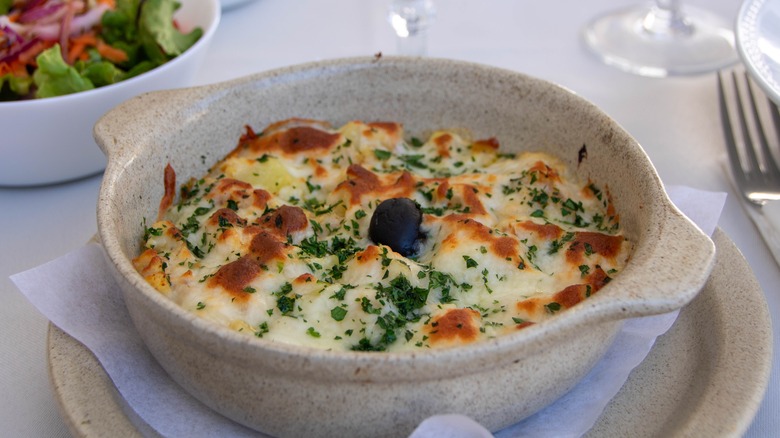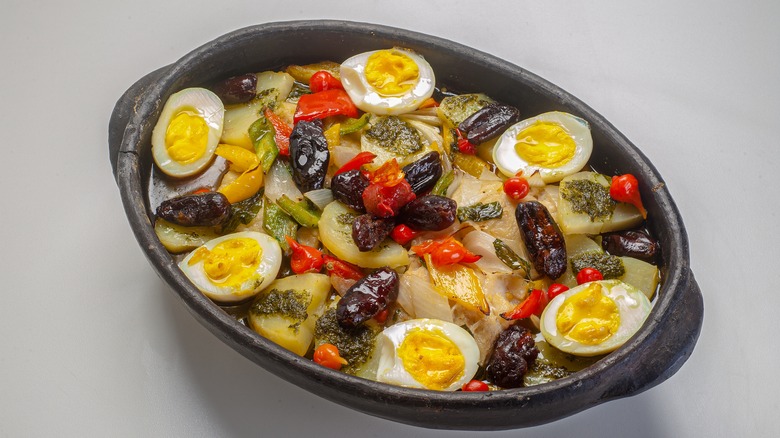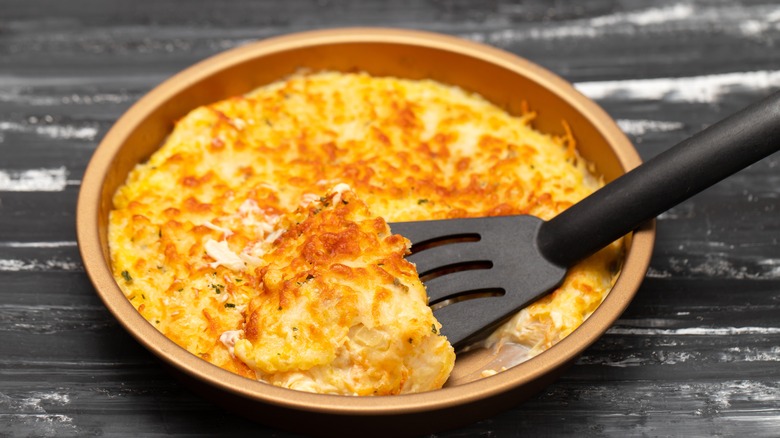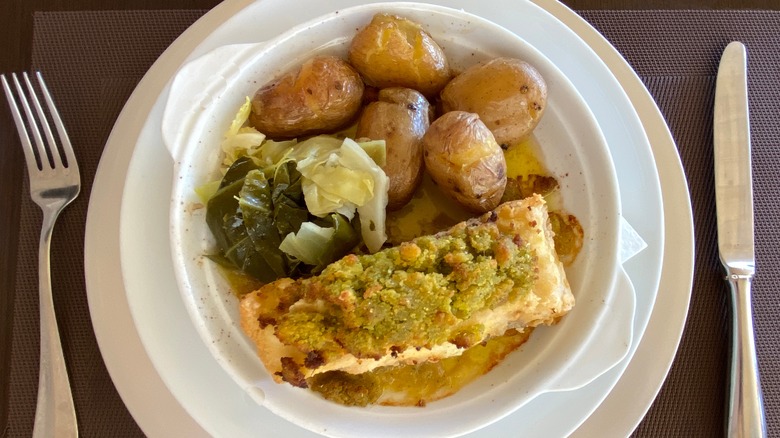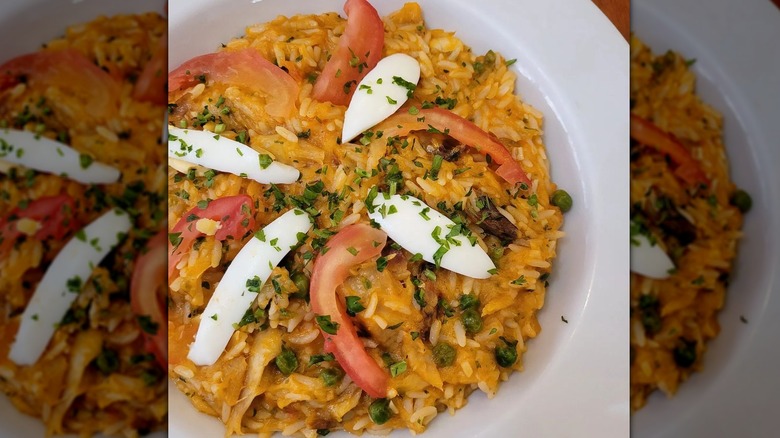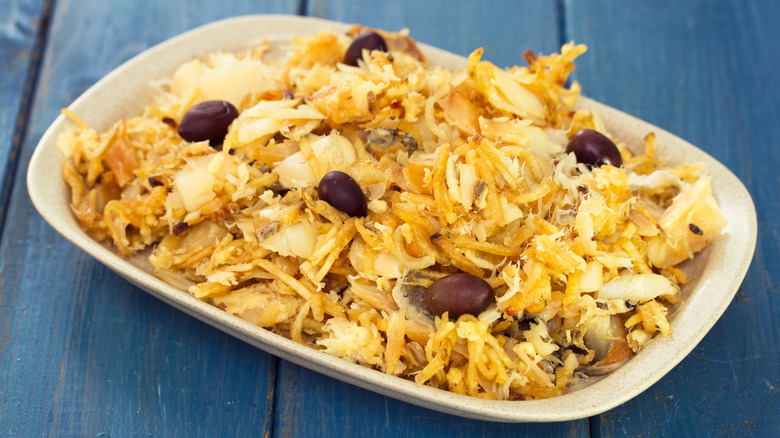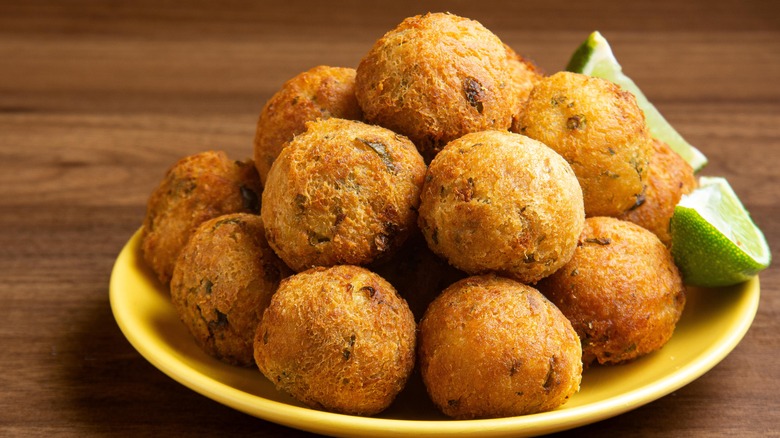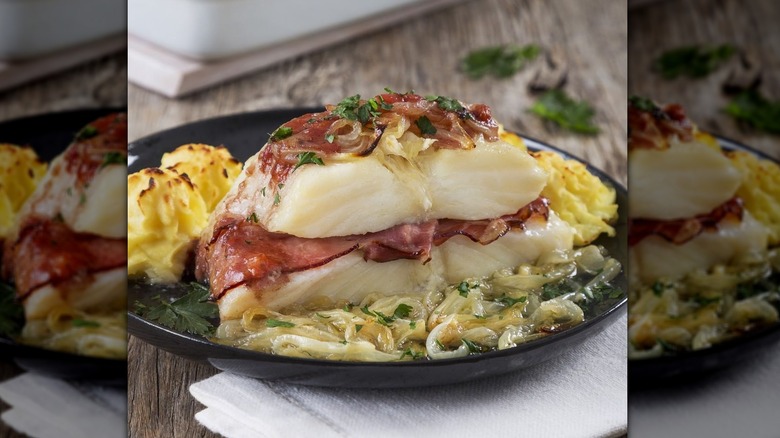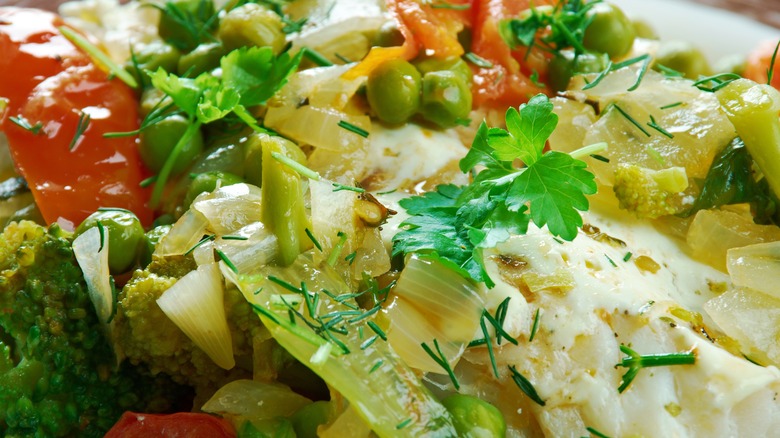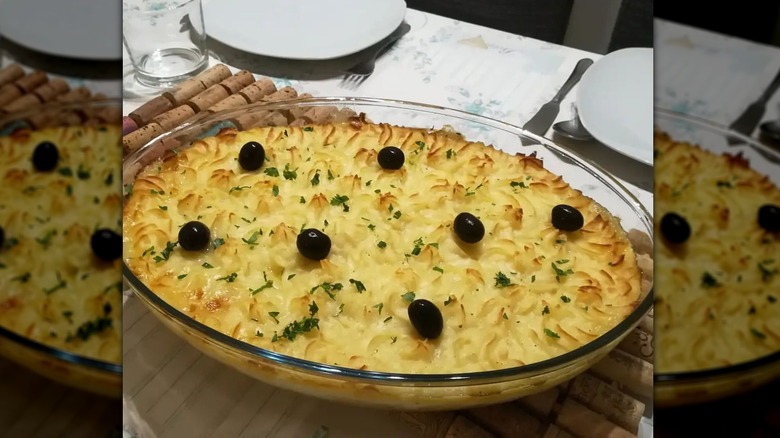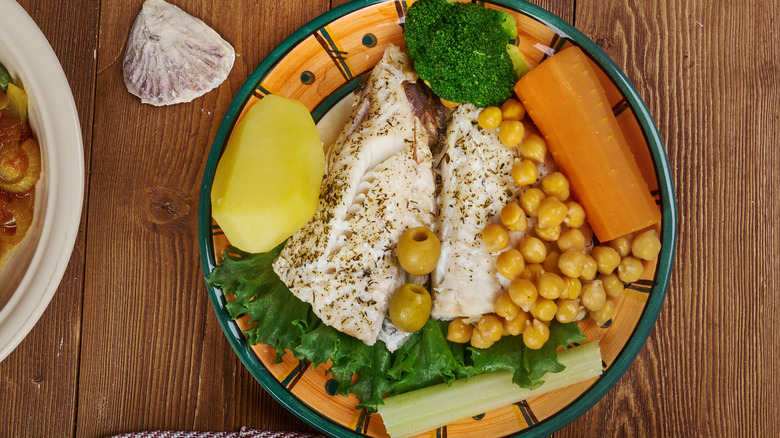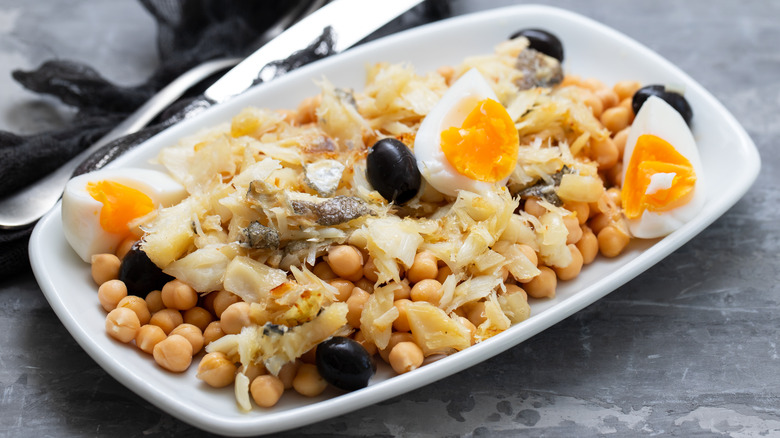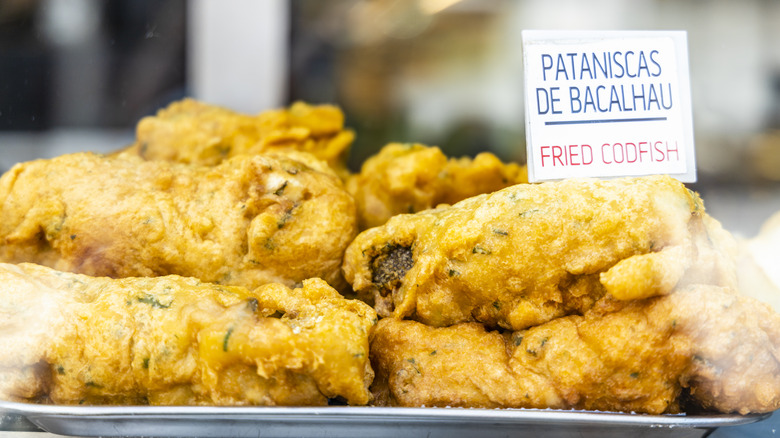14 Ways To Eat Bacalhau In Portugal
It's impossible to escape the smell of fish in Portugal. The odor wafts from sidewalk eateries, bustling markets, and even grocery store aisles. But it's not just any fish perfuming the air. Despite enjoying sea bass, bream, and sardines, it's bacalhau — preserved salt-dried cod — that reigns supreme as the country's favorite aquatic delicacy. Though not officially named a national dish or making it onto the list of the seven wonders of Portuguese gastronomy, bacalhau is a cornerstone of Portuguese cuisine. A popular saying even states that there are more than 365 bacalhau dishes, one for every day of the year.
The country's love affair with salted cod dates back to the 15th century, during the Age of Discovery. At that time, Portuguese explorers discovered plentiful cod reserves in Newfoundland and salted the fish to preserve it for the long voyage home. The cod trade boomed in the subsequent centuries, initially relying on English imports until Portugal began sourcing fish from Newfoundland and Norway in the mid-19th century.
Given just how many bacalhau dishes there are, understanding the most popular preparations will help guide your culinary explorations. From creamy gratins, such as bacalhau com natas and bacalhau espiritual, to fried treats like pataniscas and bolinhos, this guide serves up 14 ways to eat bacalhau during your next trip to Portugal.
Bacalhau à lagareiro
Pass by any tasca, a traditional home-style restaurant, and you're bound to see bacalhau à lagareiro on the menu. Also referred to as bacalhau no forno (roasted salt cod) and bacalhau assado com batatas a murro (roasted salt cod with smashed potatoes), this dish is arguably the simplest and most popular way to serve bacalhau in Portugal. Besides the fish, bacalhau à lagareiro relies on olive oil. "À lagareiro" refers to the mill workers who finished the dish with the newly prepared olive oil from Portugal's Beira region.
Preparing bacalhau à lagareiro involves roasting the codfish's loins in the oven in a generous puddle of olive oil, along with garlic and bay leaf. Not only does the olive oil infuse its rich flavor into the fish, but it's also used for basting, ensuring the fish stays moist throughout the cooking process. Accompanying the fish are smashed or punched potatoes, typically baby potatoes with the skins left on. The potatoes are parboiled, then slightly flattened with a fork or fist before getting scattered around the fish. While smashing potatoes might seem unconventional, it allows the olive oil to penetrate, resulting in a flavorful side dish.
Bacalhau com natas
Despite the relatively mild weather on the Iberian peninsula, the Portuguese still crave hearty fare during the winter. One such cold-weather comfort food is bacalhau com natas (salted cod with cream). Resembling a gratin, bacalhau com natas is an oven-baked casserole that's a Christmas mainstay throughout the country. The Portuguese love it not only because it's delicious and filling, but also for its practicality. It requires less cod than other dishes, making it perfect for using up leftovers or feeding a crowd. It's made with cod flakes, sauteed onions, fried diced potatoes, a homemade fish-infused Béchamel sauce, and fresh cream seasoned with nutmeg, pepper, and salt. The ingredients are combined in a baking dish, sprinkled with a blend of Parmesan and mozzarella, and baked until golden brown.
Like many classic Portuguese dishes, the origins of bacalhau com natas are murky. Some attribute it to João Ribeiro, a chef working in upscale Portuguese hotels in the 1930s, who experimented with cod and cream dishes during his tenure and is known for creating a similar dish called Bacalhau à Conde da Guarda.
Bacalhau à Gomes de Sá
While the history of many Portuguese bacalhau dishes remains up for debate, Bacalhau à Gomes de Sá has a clear origin story. Named after its creator, Jose Luis Gomes de Sá, a chef at Porto's Lisbonense restaurant in the late 1800s and early 1900s, this dish relies on a handful of simple, high-quality ingredients. Gomes de Sá's original recipe called for the cod to marinate in warm milk to soften it, but modern versions have done away with this step.
Nowadays, the recipe features just six ingredients: bacalhau, olive oil, waxy potatoes, onions, hard-boiled eggs, and black olives. Given how few ingredients are used, the quality of each one is essential. Preparation involves peeling, slicing, and parboiling the potatoes. These are then layered with sliced onions, olive oil, and desalted cod and baked until tender. Slice hard-boiled eggs and whole black olives are added towards the end of cooking, with fresh parsley providing the finishing touch. It's widely available in restaurants year-round, but most home cooks reserve it for their Good Friday meal.
Bacalhau espiritual
Bacalhau espiritual translates to "spiritual codfish." Unfortunately, we can't guarantee that eating this dish will lead to enlightenment, but we can attest to its deliciousness. A relatively recent addition to Portugal's culinary canon, it was invented in 1947 by Countess de Almeida Araújo. The countess developed the dish for the inauguration of Cozinha Velha, a newly opened restaurant in the National Palace of Queluz. She took her inspiration from French cuisine. More specifically, it was borrowed from brandade de morue, a bistro classic consisting of a puree of salt cod, milk, olive oil, garlic, and cream.
In combining French culinary expertise with local ingredients, the countess created this unmistakably rich dish. Despite its lofty origins, bacalhau espiritual is fairly straightforward, both in terms of ingredients and preparation. It features flaked cod loins, grated carrots, Béchamel sauce, and milk-soaked bread, topped with grated cheese and baked into a gratin. You can find this dish in nearly every Portuguese restaurant and even in the frozen foods section of the grocery store. It's usually served with a simple salad or some sauteed vegetables.
Bacalhau com broa
There are all kinds of ways to use up leftover cornbread, from dicing it into croutons to stirring it into casseroles. And it's not just American-style cornbread that proves versatile. The Portuguese transform their version of cornbread, called broa, into all kinds of tasty treats. Unlike its American counterpart, broa is leavened with yeast and lacks eggs, resulting in a sturdy loaf with an off-white crust and a golden brown interior.
Broa is usually seen alongside soup and sauces in Portuguese cuisine, but it also serves as a key ingredient in bacalhau com broa. In this recipe, chunks of broa are infused with olive oil, garlic, and coriander before being pulverized into a paste. Next, the cod is crowned with the cornbread paste and another drizzle of olive oil before baking to golden brown perfection. Typically, it's served with small smashed potatoes and sauteed cabbage to make a complete meal.
Arroz de bacalhau
Portuguese rice dishes may not have the same international reputation as risotto or biryani, but they hold their own when it comes to flavor. For example, there's arroz de pato (duck rice), a combination of slow-cooked duck, chorizo, and port wine. Then there's arroz de lingueirão, a seafood rice featuring razor clams. And it's no surprise that bacalhau, Portugal's beloved salt cod, features prominently in a local rice dish.
Arroz de bacalhau starts with local carolino rice, a short-grain variety similar to Italian Arborio rice. Its high starch content gives it a creamy texture that's perfect for soaking up all of the flavors in this dish. When it comes to the other star ingredient, bacalhau, shredded or leftover fish works well since everything is mixed. Besides rice and fish, arroz de bacalhau typically features plum tomatoes, onions, and garlic. However, some variations call for vegetables as diverse as peppers, cauliflower, and peas. In keeping with Portuguese tradition, a drizzle of olive oil before serving is the crucial last step.
Bacalhau à Brás
Like bacalhau à Gomes de Sá, bacalhau à Brás owes its name to its creator, Mr. Brás (sometimes spelled Braz), a tavern owner in Lisbon's vibrant Bairro Alto neighborhood. Reflecting the humble spirit of Portuguese cuisine, bacalhau à Brás is democratic and inclusive, relying on a handful of simple ingredients that are easy to prepare, making it accessible even to the most amateur cooks. Thanks to its simplicity, or perhaps its irresistible flavor, bacalhau à Brás quickly gained popularity, spreading throughout Portugal and even crossing the Spanish border, where it became known as bacalhau dourado.
Shredded boiled salt cod and shoestring potatoes are at the heart of this dish. Both are added to a pan along with onion and garlic. Beaten eggs come in next, providing richness and heft to the main ingredients. A bit of fresh parsley and some whole black olives add color and flavor before serving, typically alongside white rice and a simple salad. There are several variations beyond the basic recipe. For instance, sweet potato or cassava can fill in for the potato. Alternatively, heavy cream added to the eggs creates an even creamier version.
Bolinhos de bacalhau
Whether grilled, roasted, or boiled, Portuguese bacalhau takes many forms. Add fried to that list and you're in for a treat: bolinhos de bacalhau, also known as bite-sized cod fritters. Before continuing, it's worth noting that the term bolinho is used in Northern Portugal, whereas pastéis de bacalhau (cod pastries) is more common in Central and Southern Portugal. Regardless of where you find yourself in Portugal, these delectable morsels appear in bars and cafes as a snack and even in upscale restaurants as a side dish to rice and salad.
Made from shredded cod, mashed potatoes, egg, and parsley, bolinhos de bacalhau are shaped into small, egg-shaped dumplings and fried until crispy on the outside and tender on the inside. The main ingredients are fairly consistent, but plenty of chefs and home cooks play around with the ratios. Some prefer more cod than potatoes, while others use equal amounts of both. Additionally, some add nutmeg, milk, port wine, and even green chilis for a subtle twist on the classic.
Bacalhau à Transmontana
Portugal may be small, roughly the size of Indiana, but its culinary traditions are extensive and varied. Each region's cuisine reflects a blend of influences, including climate, geography, and historical factors such as immigration waves and the Catholic Church. Nowhere is that clearer than in Trás-os-Montes (Beyond the Mountains), a region in northeastern Portugal that borders Spain. What sets Trás-os-Montes cuisine apart is its use of ingredients often linked to that area, like sausages, chestnuts, cabbages, and ham.
One standout dish from the region is Bacalhau à Transmontana. It features cod loins stuffed with Portuguese jámon and bathed in a sauce made from olive oil, peeled tomatoes, white wine, port wine, onion, and garlic. But what sets this dish apart is the mashed potatoes. Rather than being unceremoniously lumped next to the main dish, tradition dictates that they should be piped into elegant mounts around the fish using a pastry bag. This technique gives the dish an unmistakable look that's impossible to resist.
Roupa velha de bacalhau
Transforming leftovers into new dishes is a common culinary practice around the world. The English remix Sunday lunch into bubble and squeak, Italians turn day-old risotto into arancini, and Mexicans transform stale tortillas into chilaquiles. The Portuguese also embrace this innovative and thrifty tradition, particularly when it comes to repurposing Christmas Eve leftovers.
A dish originating in Northern Portugal's Minho region, roupa-velha, or "old clothes," breathes new life into leftover bacalhau from Christmas Eve dinner, turning it into a whole new meal for Christmas lunch. The name isn't particularly appetizing, but it accurately reflects the colorful mix of textures and flavors present. Although initially associated with families of modest means, this practical dish has become a cherished part of Christmas for Portuguese households of all backgrounds. That's likely due in part to the simple preparation and tasty outcome. All it requires is sauteeing leftover fish with a combination of vegetables (most often carrots, Portuguese kale, and leeks), boiled eggs, and spices. Many families eat it as a main dish, although some pair it with turkey or goat.
Bacalhau à Zé do Pipo
Bacalhau à Zé do Pipo is yet another eponymous cod dish. Its creator, José Valentim (whose nickname was Zé do Pipo) was a chef working in Porto in the 1940s. Legend has it that Valentim created the dish for a competition. It's not clear if he was the victor, but its enduring popularity speaks to its success. Similar to bacalhau com natas and bacalhau espiritual, this dish takes the form of a gratin, with cod loin boiled in milk serving as the main ingredient.
Once cooked, the fish is covered with braised onions and mashed potatoes seasoned with a bit of salt, pepper, and nutmeg. The potatoes can either be spooned on top of the fish or piped on using a pastry bag for some added visual appeal. A generous layer of homemade mayonnaise is the last step before the dish heads into the oven. Mayonnaise isn't typical in Portuguese cuisine, so this unexpected ingredient makes bacalhau à Zé do Pipo stand out from similar dishes. A quick trip in the oven creates a satisfyingly crunchy golden crust, while a sprinkling of black olives adds an eye-catching accent.
Bacalhau com todos
Translated as "cod with everything," this varied dish demands no compromises. Originally served as a Christmas meal under the name bacalhau da consoada, its roots trace back to Portugal's Catholic heritage, which forbade meat consumption near religious holidays. As a result, fish, especially cod, became popular during the festive season. More specifically, this dish likely emerged in Northern Portugal during the Estado Novo dictatorship. The regime championed frugality and simplicity as national virtues and this modest dish perfectly symbolized those values.
Although it began as a seasonal tradition, these days you'll find it in Portuguese homes year-round. Preparing it doesn't require any special kitchen skills, but the timing can be tricky with all the moving parts. One part involves boiling cod loins with potatoes, carrots, and sliced Portuguese cabbage. Separately, eggs are hard-boiled and chickpeas are heated. Finally, everything is assembled on the plate and drizzled with a simple vinaigrette made from olive oil, white vinegar, and garlic.
Meia-desfeita
Roasted, boiled, and fried: Just when you think you've seen every type of bacalhau, another one appears. This time, it's in the form of a salad called meia-desfeita. The name, which translates to "half undone," comes from the fact that people used to order a half portion when times were tight. Meanwhile, the "undone" part of the name refers to the shredded appearance of the bacalhau. It originated in Lisbon and is enjoyed as a petisco (the Portuguese version of tapas), a weekday lunch, or a light dinner.
The ingredients list is short, accessible, and unpretentious. Shredded bacalhau, chickpeas, onion, olive oil, and parsley are all that's needed. These ingredients are tossed together and then seasoned with either sweet smoked paprika, vinegar, or lemon juice. Some variations incorporate additional ingredients such as hard-boiled eggs and boiled potatoes for some extra heft. As with the ingredients, the serving temperature is flexible — it tastes just as good warm as it does at room temperature.
Pataniscas de bacalhau
By this point, it should be pretty clear that the Portuguese have a deep love for bacalhau. But if you need more convincing, consider the fact that they have not one, but two recipes for cod fritters. Besides bolinhos de bacalhau, there are also pataniscas de bacalhau. Though bolinhos and pataniscas are similar in many ways, they differ in that pataniscas are made with wheat flour instead of potatoes. This swap results in a fritter that's flatter and drier, but no less delicious.
These fried delights are thought to have originated in Estremadura, a historical Portuguese province situated around Lisbon. Usually, you'll find them served as a snack in bars alongside a local lager such as Sagres or Super Bock. However, restaurants also pair them with bean or tomato rice to create a main dish. Historically, they were tucked into bread rolls to create sandwiches, although the popularity of this preparation seems to be fading.
